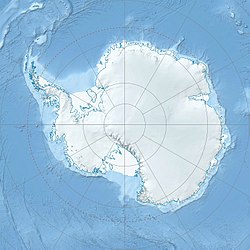Top Qs
Timeline
Chat
Perspective
Usas Escarpment
From Wikipedia, the free encyclopedia
Remove ads
Usas Escarpment (76°0′S 130°0′W) is an expansive but discontinuous north-facing escarpment in Marie Byrd Land, Antarctica. It is about 200 nautical miles (370 km; 230 mi) long, extending roughly west to east along the 76th parallel south from where the elevation of the snow surface descends toward the Ruppert Coast and Hobbs Coast. The position of the escarpment coincides with the north slopes of the Flood Range, Ames Range, McCuddin Mountains, and the eastern peaks of Mount Galla, Mount Aldaz and Benes Peak.[1]
Location of Usas Escarpment, Marie Byrd Land, Antarctica
Remove ads
Location


The western end of the range is north of the Executive Committee Range. Mount Galla is towards the northeast end. Mount Aldaz and Benes Peak are further to the east.
Exploration and name
The escarpment was observed by members of the United States Antarctic Service (USAS), 1939–41, and in ensuing scientific reports was referred to as 76th Parallel Escarpment. The approved name is an acronym for the discovery expedition.[1]
Features
Summarize
Perspective
Features of the eastern end of the escarpment, from west to east, are
Mount Galla
75°56′S 125°52′W. Snow-capped mountain 2,520 metres (8,270 ft) high which rises above the Usas Escarpment, 31 nautical miles (57 km; 36 mi) east of Mount Petras in the McCuddin Mountains. Mapped by the United States Geological Survey (USGS) from surveys and United States Navy air photos, 1959-65. Named by the United States Advisory Committee on Antarctic Names (US-ACAN) for Lieutenant Edward J. Galla, United States Navy, who was medical doctor and leader of support personnel at Byrd Station, 1959.[2]
Mount Aldaz
76°03′S 124°25′W. A projecting-type mountain 2,520 metres (8,270 ft) high that barely protrudes from the ice-covered Usas Escarpment, 22 nautical miles (41 km; 25 mi) east-southeast of Mount Galla. The mountain is mostly ice covered, but has notable rock outcropping along its northern spur. Surveyed by USGS on the Executive Committee Range Traverse of 1959. Named by US-ACAN for Luis Aldaz, Meteorologist and Scientific Leader at Byrd Station, 1960.[3]
Benes Peak
76°02′S 124°07′W. A peak 2,450 metres (8,040 ft) high that is almost entirely snow covered, situated along the Usas Escarpment, 4 nautical miles (7.4 km; 4.6 mi) east of Mount Aldaz. Surveyed by USGS on the Executive Committee Range Traverse of 1959. Named by US-ACAN for Norman S. Benes, USARP meteorologist at Byrd Station, 1961.[4]
See also
References
Sources
Wikiwand - on
Seamless Wikipedia browsing. On steroids.
Remove ads
